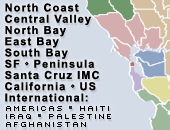From the Open-Publishing Calendar
From the Open-Publishing Newswire
Indybay Feature
Somalia:The failings of war on terror
The recent US air raid, which killed Aden Hashi Eyrow, one of senior leaders of Somalia’s Islamist movement, shows how Somalia has become the second key front of US’s war on terror after Afghanistan. The commonality between Somalia and Afghanistan, two anarchy fountain countries, is striking, according to the Senlis Council, an international think tank. Both countries are epicentres of war on terror and demonstrate how this war is aggravating the calamitous situations that already existed in these two countries.
The Senlis Council has recently published a 79-page report which takes a close look at the impact of the war on terror using Somalia and Afghanistan as case studies. The report identifies a catalogue of failings which cause “policy paralysis and increasing instability”.
Here are some of the persistent problems:
Misreading the context. Without proper evaluation mechanisms of success and failure, without defining the scope of military action, and without committing the necessary intelligence and diplomatic effort, the US has exacerbated the instability that already existed in these countries. On Afghanistan, the report says, “Afghanistan's resurgent Taliban provide a bleak example of how failing US-led War on Terror policies have promoted extremists to a level of political legitimacy they would never ordinarily achieve.” On Somalia, the report states, “These [US] bombings and sponsorship of a proxy Christian army – Ethiopia – to fight in Mogadishu have provided militant Islamists with abundant propaganda material.”
Long before the September 11 attacks, Somalia and Afghanistan were war-ravaged countries; the heart of the wars was local and regional power struggles and clan conflicts. After the attacks, many local and regional actors have jumped aboard America’s war on terrorism bandwagon to get financial and military muscle in order to suppress their rivals. They have massaged US government’s interests until they are in accord with their own interests. Unfortunately, America has failed to distinguish between genuine international threats and conflicting local and regional interests.
The report observes a new phenomenon in Somalia – suicide. According to the report, 3 suicide attacks were carried out in 2007 in Somalia while there were 137 attacks in Afghanistan. Before Ethiopia’s invasion of Somalia, Somalia never had a suicide attack in all its troubled history. This indicates how Ethiopia’s presence in Somalia has worsened the situation and attracted freelance jihadists.
Over-militarised solution. Using excessive military power and paying no attention to the human cost is making this war unpopular. For example, on 8 January 2007, the US Air Force used AC-130 to launch an air strike against three Al-Qaeda suspects in southern Somalia. Even those who are familiar with the US operations were surprised that the US had chosen an AC-130 gunship. Startfor, a private intelligence agency, says, “Using an AC-130 gunship to eliminate specific militant suspects marks a departure from typical U.S. practice.” A few days after, on 13 January 2007, the Independent reported, “Oxfam yesterday confirmed at least 70 nomads in the Afmadow [southern Somalia] district near the border with Kenya had been killed.”
More
Here are some of the persistent problems:
Misreading the context. Without proper evaluation mechanisms of success and failure, without defining the scope of military action, and without committing the necessary intelligence and diplomatic effort, the US has exacerbated the instability that already existed in these countries. On Afghanistan, the report says, “Afghanistan's resurgent Taliban provide a bleak example of how failing US-led War on Terror policies have promoted extremists to a level of political legitimacy they would never ordinarily achieve.” On Somalia, the report states, “These [US] bombings and sponsorship of a proxy Christian army – Ethiopia – to fight in Mogadishu have provided militant Islamists with abundant propaganda material.”
Long before the September 11 attacks, Somalia and Afghanistan were war-ravaged countries; the heart of the wars was local and regional power struggles and clan conflicts. After the attacks, many local and regional actors have jumped aboard America’s war on terrorism bandwagon to get financial and military muscle in order to suppress their rivals. They have massaged US government’s interests until they are in accord with their own interests. Unfortunately, America has failed to distinguish between genuine international threats and conflicting local and regional interests.
The report observes a new phenomenon in Somalia – suicide. According to the report, 3 suicide attacks were carried out in 2007 in Somalia while there were 137 attacks in Afghanistan. Before Ethiopia’s invasion of Somalia, Somalia never had a suicide attack in all its troubled history. This indicates how Ethiopia’s presence in Somalia has worsened the situation and attracted freelance jihadists.
Over-militarised solution. Using excessive military power and paying no attention to the human cost is making this war unpopular. For example, on 8 January 2007, the US Air Force used AC-130 to launch an air strike against three Al-Qaeda suspects in southern Somalia. Even those who are familiar with the US operations were surprised that the US had chosen an AC-130 gunship. Startfor, a private intelligence agency, says, “Using an AC-130 gunship to eliminate specific militant suspects marks a departure from typical U.S. practice.” A few days after, on 13 January 2007, the Independent reported, “Oxfam yesterday confirmed at least 70 nomads in the Afmadow [southern Somalia] district near the border with Kenya had been killed.”
More
For more information:
http://www.garoweonline.com/artman2/publis...
Add Your Comments
Latest Comments
Listed below are the latest comments about this post.
These comments are submitted anonymously by website visitors.
TITLE
AUTHOR
DATE
American backed ethiopian genocide of somalia
Sat, May 3, 2008 4:54PM
We are 100% volunteer and depend on your participation to sustain our efforts!
Get Involved
If you'd like to help with maintaining or developing the website, contact us.
Publish
Publish your stories and upcoming events on Indybay.
Topics
More
Search Indybay's Archives
Advanced Search
►
▼
IMC Network



